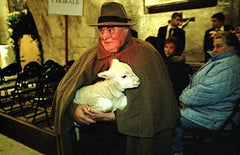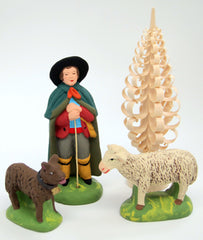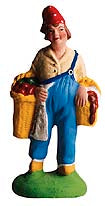The Fisherman - the Sixteenth (16th) Essential Santon for a Provençal Creche
The Fisherman is number 16 on the list of the top 20 Essential Santons for a Provençal Creche. He is a pivotal figure in Provence, whether he works with his nets in the sea, or, as an angler, casting his pole into a local stream. As a Santon, his origin is in the early nativity plays and creche-parlant. Foremost, he is a classic figure of the Port of Marseille and its very important fishing trade of the Mediterranean. Fish, whether freshwater or from the sea, are basic to the Provençal diet. The Carbonel Santons workshop has created variations of each.
The Fishermen of the sea are represented by the Fisherman with a net - Pécheur au filet (French) - Lou Pescadou (Provençaux), available in all 4 sizes.
and the Octopus Fisherman - Pécheur au poulpe, in Size #3
They wear a seaman's jersey, have the trousers rolled up to their knees, wear red cotton caps on their heads, and are barefoot.
The Fishermen of freshwater are represented by the Angler – Pêcheur à la ligne (French) - Lou Pescaire (Provençaux), available in all 4 sizes.
and the Seated Fisherman – Pêcheur Assis, in Sizes #2 and #1
These two seated anglers are perfect to place by the side of a stream, or next to the bridge.
Of course, one cannot think of the Fisherman without thinking of the Fishwife - number 14 of the top 20 essential Santons.
Frederic Mistral, a Provençal poet, a winner of the Nobel Prize in Literature (1904), and a champion of the Occitan language (of which Provençaux is a dialect) of southern France, famously celebrated the Provencal fisherman in his epic poem of 1867, Calendal. In creating Calendal (the word "Calendula" is the Provençaux equivalent of "Noel" and was commonly given to each child born on Christmas Day), an anchovy fisherman from Cassis, Mistral invented "the Christmas fisherman." Calendal conquers monumental tasks, including inventing "ingenious fishing devices to bring all the fish of the sea into the port..." to win over his sweetheart, half-princess/half-fairy, Esterelle, a descendant of the Lord of Baux. The poem, a tribute to Provence, put Cassis on the map and sealed the importance of the Santon Fisherman. Calendal is commemorated in a statue by the harbor made of limestone from Cassis. As Mistral is often quoted: "He who has seen Paris and not Cassis has seen nothing."
Provençal legend tells us that before making his way to the manger, the fisherman first had to catch a fish to take as his gift. He "spent the night on the river, casting in vain. The water was cold and his hands were freezing,... A friend along the riverbank shouted the news of the Christ Child's birth. When a great trout overheard...." (Foley, p. 115) he took the bait deliberately, not to be left behind those wanting to see Jesus. Thus, the fisherman was able to successfully present the gift of his trade to the Christ Child.
The Hunter - the Fifteenth (15th) Essential Santon for a Provençal Creche
The Hunter- Le Chasseur (French) – Lou Cassaire (Provençaux) is number 15 on the list of the top 20 Essential Santons for a Provencal Creche. He is available in all four Marcel Carbonel Santons sizes.
He hunts the low, soft-leafed, scrublands of Provence - the "garrigues." His outfit is classic: a natty jacket, a broad-brimmed black hat and boots, his gun in one hand, a rabbit in the other, and his game-bag over his shoulder.
Like the infamous fisherman's yarn of the one who got away, the hunter spins his own tall tales and boasts of his exploits in his never-ending efforts to bag the perfect rabbit. It is a rabbit, or a hare, or perhaps a skewer of birds, that he brings as his gift to the Christ Child.
According to Daniel Foley, it was Santonnier Leon Simon (1845-1916) who introduced the hunter to the Santons creche.
For photos of the history and workshop of Carbonel enjoy our Marcel Carbonel Santons board on Pinterest.
The Fishwife - the Fourteenth (14th) Essential Santon for a Provençal Creche
The Fishwife - Poissonnière (French) - Le Peissouniero (Provençaux) is number 14 on the list of the top 20 Essential Santons for a Provençal Creche. She is available in all four of the Marcel Carbonel Santons sizes offered by My Growing Traditions. Colorfully dressed, she has a portable scale (copper steelyard) fastened to her belt and with a proud humility commonly brings a bountiful gift of not one, but two, basketfuls of fish to the manger.
As a fishwife, or fishlass, she is a woman who sells or works with fish. She is not necessarily a married woman, as the word "wife" here simply means woman. She is the female version of a fishmonger. Of course, she may indeed be the fishmonger's wife. She may be rough around the edges, but she is a hearty soul - one who has existed in Provencal life "forever" and thus, equally important to the Santons creche. She is celebrated in this 1995 French postage stamp.
We picture her as the wife or co-worker of the Fisherman with the Net, also available in all four of the Santons sizes that we have available.
In the pastorale of Jean-Francois Audibert, Pistachié is the husband of Honorine, a fishwife.
Man with a Drum - Tambourinaire – the Thirteenth (13th) Essential Santon for a Provençal Creche
The Man with a Drum - Tambourinaire (French) - Lou Tambourin (Provençaux) is number 13 on the list of the top 20 Essential Santons for a Provençal Creche. He is available in all four of the Marcel Carbonel Santons sizes offered by My Growing Traditions.
The drummer is distinguished and colorful in his band "uniform." Carbonel has him dressed in a grey, wide-brimmed hat, a black jacket over a white shirt adorned by a red cravate, and white trousers with a broad ban of red wool called a "taiolo" around his wasit.
The man with the drum is a popular figure in the world of Santons. He is no ordinary drummer, being: the earliest Provencal musician, instrumental in the creation of the Farandole, and, to this day, present in Christmas and other important village celebrations.
The Carbonel workshop also offers a Woman with a Drum - the Femme Tambourinaire - in two sizes: Sizes #3 (Grande) and #2 (Elite).
Their instruments, the "galoubet" (a three-finger holed pipe, record, flute, or fife)

and the "tambourin" (a long cylindrical drum)

are the two instruments traditional to Provence.
The galoubet dates back to 1723 and is a unique pipe that is played only with the left hand. The tambourin dates from the 16th century and is played with the right hand using a hammer called a massette (the massette is shown beneath the galoubets in the photo below). The two instruments, played by one musician at the same time, work perfectly together providing the melody (the galoubet) and the rhythm (the drum).

Daniel Foley, 1959 book Little Saints of Christmas: The Santons of Provence, tells of the legend of "Galoubet" and how it was he who initiated the dance of the Farandole. According to the tale, Galoubet (and, yes, the legend has his name as the same as the name of his flute), the drummer, was playing at a part on Christmas Eve. Midnight curfew came, yet "on that night of nights, no one seemed to have any notion of retiring. So Galoubet played on and the young folks continued to dance. Suddenly a patrol arrived at the square. But it did not disturb him, and the dance continued. Despite his weariness, he wandered toward the outskirts of the town, followed by the dancers. Early morning risers rushed to their windows to see what was going on.... the dance continued, and as the people of Provence will tell you, this was the beginning of the Farandole, the best-loved of all the folk dances. It had been created to do honor to the Christ Child, and so the merry troupe made their way to the manger, for Bethlehem was close by. Everything had been set topsy-turvy that night, and no one seemed to know why. The dancing stopped and the gaiety subsided as the boys and girls approached the manger, and all knelt down to give their homage. But to Galoubet, prayer was music. It was all he knew. On he went, playing the music of the Farandole." (Foley, p. 110)
For photos of the history and workshop of Carbonel enjoy our Marcel Carbonel Santons board on Pinterest.
Carbonel Santons Shepherd Gift Sets
It was to the shepherd that the Angel came to announce the birth of Jesus - the Shepherd spread the word and summoned the Provencal villages to the manger. Thus, the Shepherd can be considered the pivotal Santon in the Provencal creche. Each year his role is celebrated across Provence in Christmas Eve services.
At midnight, the service begins with the Shepherd's Carol, the Carol Pastre di mountagno.
My Growing Traditions has created Marcel Carbonel Santons Shepherd gift sets in three sizes. Size #3 (Grande),
Each set includes the Young Shepherd, his herding dog, a standing sheep and a hand-carved tree (Spanbaum) from the Erzgebirge, Germany and is at a special price providing savings over purchasing the Santons separately. All are tucked neatly into a gift box from My Growing Traditions and include a My Growing Traditions Shepherd card.
For photos of the history and workshop of Carbonel enjoy our Marcel Carbonel Santons board on Pinterest.
Mr. Jourdan – the Twelfth (12th) Essential Santon for a Provençal Creche
Mr. Jourdan - Monsieur Jourdan (French) is number 12 on the list of the top 20 Essential Santons for a Provençal Creche. He is available in three of the Marcel Carbonel Santons sizes offered by My Growing Traditions: Size 3, Size 2, and Size 1.
Stemming from the early Christmas play, the Pastorale of Antoine Maurel, Mr. Jourdan and his wife, Margarido, are symbols of the middle class. Margarido is the eighth essential Santons for a Provencal Creche, and clearly where she goes, he goes.
Margarido is infamous as a woman with a very bad temper who nags her husband. In the Pastorale, Roustido belatedly, as a latecomer, and in the middle of the night, beckons the couple to scurry to the Stable. Margarido comfortably and proudly rides her donkey, while trying to hurry along her husband as he trudges along beside them.
Mr. Jourdan is nattily dressed in his "opera hat, cravate, embroidered waistcoast, white stockings and shoes with silver buckles." He brings a basket filled with food to the nativity. (Carbonel Dictionary)
You may enjoy our Pinterest Board on Marcel Carbonel Santons for photos of history and the making of Santons.
Bartholomew – the Eleventh (11th) Essential Santon for a Provençal Creche
Bartholomew – Bartoumieu (Provençaux) is number 11 on the list of the top 20 Essential Santons for a Provençal Creche. He is available in all four Marcel Carbonel Santons sizes offered by My Growing Traditions.
A character from the nativity plays (pastorales), Bartholomew, the village innkeeper (the word innkeeper is l'Oste in Provençaux), is proudly featured on Marcel Carbonel's brochures. He is one of the most loved and comical characters of the Provençal nativity and is, in fact, often the hero of these tales. He is a simple chap: friendly, cheerful, and an all around genial soul - looking at the world with a thoroughly positive nature. He has a tendency to get a little too tipsy from time to time and the miracle he receives upon reaching the nativity is to be cured of his drunkenness.
In his hurry, he has hastily dressed and his clothing is in a bit of disarray. He traditionally brings cod (essential to the Provençal dish l'aioli) and baskets of food to the Christ Child.
For photos of the history and workshop of Carbonel enjoy our Marcel Carbonel Santons board on Pinterest.


















































